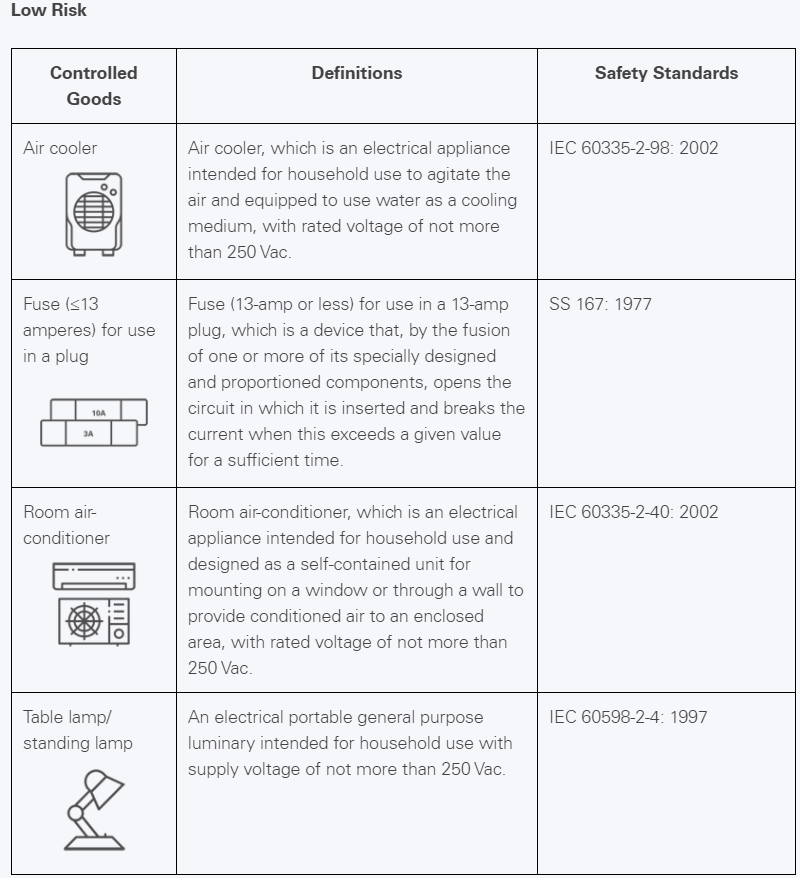
Household gas and electrical appliances posing higher potential hazards to their consumers are required by law to be affixed with a valid SAFETY Mark before they can be sold in Singapore.
Examples of these hazards can include:
| Electrocution | Fires | Explosions |
In order for a household gas or electrical appliance to qualify for a SAFETY Mark, its design must be tested and certified by the relevant accredited bodies to comply with the appropriate Safety Standards.
Why should you insist on the SAFETY Mark?
The SAFETY Mark indicates that the products’ design has been tested and certified to be compliant with the relevant safety standards. For most appliance categories, the presence of the SAFETY Mark also indicates that internal safeguards have been incorporated to protect against fire and electrical hazards.
What are the appliances tested for?
Here are some of the requirements* that common household appliances must meet in order to qualify for the SAFETY Mark.
* Images shown are for illustration purposes only. Position of labelled components may differ in actual appliance.
Ceiling Fan
| [1]: Suspension must have adequate strength to withstand mechanical stresses from daily use [2]: Screws, bolts and nuts connecting the suspension system must not come loose [3]: Moving parts must not cause undue stress to electrical connections |
Glass-topped Gas Hob
| [1]: Parts exposed to flames must be able to withstand heat and corrosion [2]: Presence of safety devices to avoid accumulation of harmful unburnt gas if flame is extinguished [3]: Internal components must be designed to limit gas leakage [4]: Glass must be resistant to heat and mechanical stress |
Instantaneous Heater
| [1]: Heater must be able to withstand humid conditions [2]: Incorporate safeguards (e.g. overcurrent protective device) to reduce risk of fire and electric shocks [3]: Components carrying electrical currents must be properly insulated [4]: External enclosure must be designed to limit risk of potential electric shocks |
Refrigerator
| [1]: Cooling system designed to: – Limit fire/explosion risks in event of refrigerant leaks – Withstand refrigerant at high pressure [2]: Compressor must not reach abnormally high temperatures during use [3]: External enclosure must be constructed from material that are resistant to ignition and spread of fire |
3-Pin Plug
| [1]: Plug incorporates fuse that complies with safety requirements [2]: Insulating material must be sufficiently resistant to electricity and fire [3]: Power cord must be able to withstand mechanical stress. Breakage can cause short circuit and/or electrocution |
What kind of household products require the SAFETY Mark?
Household electrical, electronic and gas appliances and accessories
- 33 categories of household electrical, electronic and gas appliances and accessories are classified under the Consumer Protection (Safety Requirements) Regulations as Controlled Goods. They are required to be registered with Enterprise Singapore and affixed with the SAFETY Mark on the product or packaging before they can be sold in Singapore. Examples of Controlled Goods are kettles, water heaters, televisions, microwave ovens, portable 3-pin socket-outlets and fans.
- Check if the SAFETY Mark on the product is valid by entering either the model number or the 8-digit registration number into Enterprise Singapore’s Register of Registered Controlled Goods.
- When buying electrical appliances and electronic goods, check the voltage rating label on them to ensure that they are suitable for local use. The mains sockets in Singapore supply 230V. Also, ensure that the appliance comes with appropriate mains plug:
- 13A and 15A 3-pin mains plugs that have been registered with Enterprise Singapore and are affixed with the SAFETY Mark
- 2.5A 2-pin mains plugs
General consumer goods
- Avoid making your decision to purchase any item solely based on price. Product safety is of equal importance in the consideration process.
- Research on the type of product you want to buy and gather tips on what to look out for.
- Check the product description, its functions and age recommendation for the product you are buying.
- Buy from reputable retailers and when making an online purchase, check if the product meets safety standards and is suitable for local use.
- Check if the product comes with instructions and manufacturer/distributor information.
- Inspect the product you are buying for any damage. Look out for sharp edges as well as loose or missing parts.
Use products safely
- Read safety warnings and instructions on assembly, installation, usage and maintenance. Follow them strictly.
- Use products only for their intended purpose
- Do not make assumptions on how to use a product just because you have used a similar product in the past. Always refer to the safety information supplied.
- Ask the seller for help if the product’s intended use or instructions are not clear.
- Assess if children need to be supervised when using a product.
- Assess if you need to keep a product out of the reach of young children.
- Stop using product when signs of wear and tear such as cracks are observed.
- Do not use electrical appliances near wet areas and bathtubs, basins or other vessels containing water.
